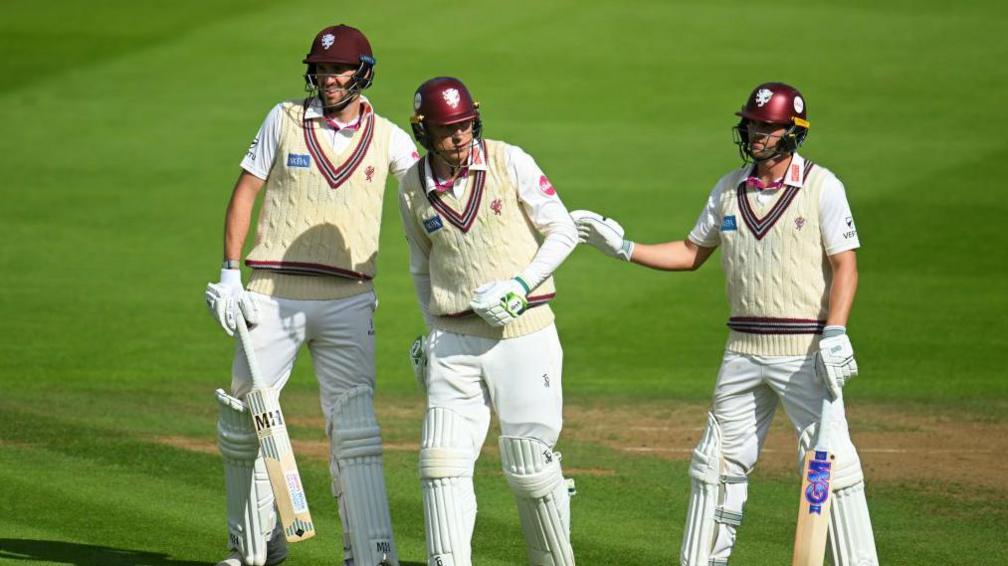Can a batter have a runner in Test cricket?
- Published
In Test cricket, injured batters are not permitted to have another player as a runner.
The rule is stated in condition 25.5 of the International Cricket Council's Men's Test Playing Conditions.
A batter is permitted to retire as not out due to injury, illness or any other unavoidable cause and is allowed to resume their innings.
The retired batter is only then able to continue their innings at the point where either a wicket falls or another batter retires.
Should a player retire for any reason other than injury, illness or an unavoidable cause, they would be retired out and not allowed to carry on later in that innings.
The only scenario where a batter is allowed to be replaced is if a batter is deemed to have or potentially have concussion. In this instance, another player from that team is able to be used as a concussion substitute and will replace them for the rest of the Test match.
Until 2011, runners were often seen in international cricket. They would run between the wickets for players who could still bat but could not run. The runner would position themselves at square leg when the injured batter was on strike. When the injured batter was not on strike, the runner stood at the non-striker's end.
Get in touch
Send us your questions
Rules on substitute fielders

In 2024, Tom Lammondby (right) featured as a runner for Surrey following an injury to batter Tom Banton (centre), with runners permitted in the County Championship
In the instance where a player comes off the field while fielding, they are allowed to be replaced by a substitute in the instance of injury, illness or another reason accepted by the umpires.
However, this substitute is not permanent and only covers some or all of the innings in which that team is fielding.
Substitute fielders are allowed to be the team's designated wicketkeeper but are not allowed to bowl or carry out captaincy duties.
Should a player have a non-concussion related injury, they must either bat through the injury or not bat at all, reducing their team to 10 batters.
Should substitutes be allowed in Test cricket?
Michael Vaughan and Sir Alastair Cook discuss whether there should be injury substitutions
On the evening of the first day of the fourth Test between England and India at Old Trafford, India wicketkeeper and vice-captain Rishabh Pant was forced off the field on the back of a buggy after sustaining an injury to his right foot.
Pant initially retired but returned to bat on day two despite struggling to even walk down the stairs of the Old Trafford pavilion.
Former England captains Michael Vaughan and Sir Alastair Cook debated the topic following the incident.
"I don't like that we've got four days left of action [as part of] an incredible series where we're going to have 10 v 11," said Vaughan.
"Once they brought in concussion subs, I was crying out saying let's just bring in substitutes in the first innings of a game. That would be my stepping point."
Cook added: "I'm not sure I agree, I'm not sure what I think.
"We've just Pant walk off, he looks in all kinds of pain and [his foot] is not broken. Nothing on the x-ray is broken, it is just a bruise.
"If it's a broken foot, it's different thing but if you just get hit and it's a bruise, it's only a bruise. It is discomfort and you can't hold a bat as well as you would like, but it is just a bruise."
This article is the latest from BBC Sport's Ask Me Anything team. This question comes from David in Croydon. Thanks, David!
What is Ask Me Anything?
Ask Me Anything is a service dedicated to answering your questions.
We want to reward your time by telling you things you do not know and reminding you of things you do.
The team will find out everything you need to know and be able to call upon a network of contacts including our experts and pundits.
We will be answering your questions from the heart of the BBC Sport newsroom, and going behind the scenes at some of the world's biggest sporting events.
Our coverage will span the BBC Sport website, app, social media and YouTube accounts, plus BBC TV and radio.